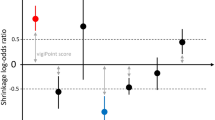Abstract
Background
In the treatment of depression, it is essential to monitor for early warnings of suicide.
Objective
The aim of this study was to identify the symptoms that would suggest a high suicide risk by analyzing data obtained from the US Food and Drug Administration Adverse Event Reporting System (FAERS) of selective serotonin reuptake inhibitors.
Methods
Using FAERS reports from 1997 to the second quarter of 2012, we constructed the co-occurrence network of adverse events. From this network, we extracted the events that were strongly connected to suicidal events (suicidal attempts, suicidal ideation, suicidal behavior, and complete suicide) by means of the community detection method.
Results
We succeeded in obtaining a list of suicide-related adverse events. Owing to the randomness inherent in the algorithms of community detection, we found that the obtained list differed according to each trial of analysis. However, the lists we derived show considerable efficiency in identifying suicidal events.
Conclusion
The network analysis appears to be a promising method for identifying signals of suicide.






Similar content being viewed by others
Notes
MedDRA®, the Medical Dictionary for Regulatory Activities terminology, is the international medical terminology developed under the auspices of the International Conference on Harmonization of Technical Requirements for Registration of Pharmaceuticals for Human Use (ICH). The MedDRA® trademark is owned by the International Federation of Pharmaceutical Manufacturers and Associations (IFPMA) on behalf of ICH.
References
Harris EC, Barraclough B. Suicide as an outcome for mental disorders. A meta-analysis. Br J Psychiatry. 1997;170:205–28.
Mann JJ, Waternaux C, Haas GL, Malone KM. Toward a clinical model of suicidal behavior in psychiatric patients. Am J Psychiatry. 1999;156:181–9.
Reihmer Z. Suicide and bipolar disorder. In: Zarate CA, Manji HK, editors. Bipolar depression: molecular neurobiology, clinical diagnosis and pharmacotherapy. Basel: Birkhäuser; 2009. p. 47–56.
Vaswani MK, Linda FK, Ramesh S. Role of selective serotonin reuptake inhibitors in psychiatric disorders: a comprehensive review. Prog Neuropsychopharmacol Biol Psychiatry. 2003;27:85–102.
Szarfman A, Machado SG, O’Neill RT. Use of screening algorithms and computer systems to efficiently signal higher-than-expected combinations of drugs and events in the US FDA’s spontaneous reports database. Drug Saf. 2002;25:381–92.
Hauben M, Madigan D, Gerrits CM, Walsh L, Van Puijenbroek EP. The role of data mining in pharmacovigilance. Expert Opin Drug Saf. 2005;4:929–48.
Piccinni C, Motola D, Marchesini G, Poluzzi E. Assessing the association of pioglitazone use and bladder cancer through drug adverse event reporting. Diabetes Care. 2011;34:1369–71.
Gunguly N, Deutsh A, Mukherjee A, editors. Dynamics on and of complex networks: application to biology, computer science, and the social sciences. Basel: Birkhäuser; 2009.
Liljeros F, Edling CR, Amaral LAN, Stanley HE, Aberg Y. The web of human sexual contacts. Nature. 2001;411:907–8.
Pastor-Satorras R, Vespignani A. Immunization of complex networks. Phys Rev E. 2002;65:036104.
Alon U. An introduction to systems biology: design principles of biological circuits. London: Chapman and Hall; 2006.
Barabási AL. Network medicine: from obesity to the “diseasome”. N Engl J Med. 2007;357:404–7.
DuMouchel W. Bayesian data mining in large frequency tables, with an application to the FDA spontaneous reporting systems. Am Stat. 1999;53:177–90.
Harpaz R, Chase HS, Friedman C. Mining multi-item drug adverse effect associations in spontaneous reporting systems. BMC Bioinform. 2010;11(Suppl. 9):S7.
Newman MEJ. Modularity and community structure in networks. Proc Natl Acad Sci USA 2006;103:8577–8582.
American Society of Health-System Pharmacists. AHFS drug information 2010. Maryland: American Society of Health-System Pharmacists; 2010.
Wishart DS, Knox C, Guo AC, et al. DrugBank: a knowledgebase for drugs, drug actions and drug targets. Nucleic Acids Res. 2008;36:D901–6.
Newman MEJ. Finding and evaluating community structure in networks. Phys Rev E. 2004;69:026113.
Guimerà R, Sales-Pardo M, Amaral LAN. Modularity from fluctuations in random graphs and complex networks. Phys Rev E. 2004;70:R025101.
Rosvall M, Bergstrom CT. An information-theoretic framework for resolving community structure in complex network. Proc Natl Acad Sci USA. 2007;104:7327–31.
Blondel VD, Guillaume JL, Lambiotte R, Lefebvre E. Fast unfolding of communities in large networks. J Stat Mech. 2008;2008:P10008.
Fortunato S, Barthélemy M. Resolution limit in community detection. Proc Natl Acad Sci USA. 2007;104:36–41.
Lambiotte R, Delvenne J -C, Barahona M. Laplacian dynamics and multiscale modular structure in networks [internet]. 2008. arXiv:0812.1770.
Bastian M, Heymann S, Jacomy M. Gephi: an open source software for exploring and manipulating networks. In: International AAAI conference on weblogs and social media; 17–20 May 2009, San Jose, USA. http://www.aaai.org/ocs/index.php/ICWSM/09/paper/view/154. Accessed 23 Mar 2014.
Huang L, Zalkikar J, Tiwari RC. A likelihood ratio test based method for signal detection with application to FDA’s drug safety data. J Am Stat Assoc. 2011;106:1230–41.
Huang L, Guo T, Zalkikar JN, Tiwari RC. A review of statistical methods for safety surveillance. Ther Innov Regul Sci. 2014;48:98–108.
Conflict of interest statement
No external sources of funding were used in the preparation of this study. Alwis Nazir, Takashi Ichinomiya, Nobuteru Miyamura, Yasuaki Sekiya and Yasutomi Kinosada have no conflicts of interest that are directly relevant to the contents of this study.
Author information
Authors and Affiliations
Corresponding author
Rights and permissions
About this article
Cite this article
Nazir, A., Ichinomiya, T., Miyamura, N. et al. Identification of Suicide-Related Events Through Network Analysis of Adverse Event Reports. Drug Saf 37, 609–616 (2014). https://doi.org/10.1007/s40264-014-0195-2
Published:
Issue Date:
DOI: https://doi.org/10.1007/s40264-014-0195-2




